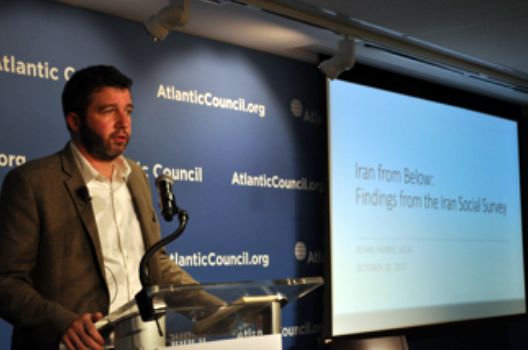 As the Trump administration formulates a new policy toward Iran, it is important that that policy be informed by accurate information about the realities of Iran’s rapidly changing society. On October 18, 2017, the Atlantic Council’s Future of Iran Initiative hosted sociologist and author Kevan Harris on the findings of the first Iran Social Survey, which challenged some prevailing views about the composition of Iranian society and presumed linkages between government benefits and voters’ political preferences.
As the Trump administration formulates a new policy toward Iran, it is important that that policy be informed by accurate information about the realities of Iran’s rapidly changing society. On October 18, 2017, the Atlantic Council’s Future of Iran Initiative hosted sociologist and author Kevan Harris on the findings of the first Iran Social Survey, which challenged some prevailing views about the composition of Iranian society and presumed linkages between government benefits and voters’ political preferences.
The first nationally representative survey of social relations conducted in the Islamic Republic of Iran since the 1979 revolution, the sample of 5005 respondents, fielded in December 2016, contains rich data on family history, electoral behavior, ethnic identity and contemporary state-society relations.
An Assistant Professor of Sociology at the University of California, Los Angeles, Harris, spoke at length about the uniqueness of the survey through its five modules: Inter-generational mobility, political mobilization, state services, civic association and ethno-linguistic identification. Factors used in the survey included: voter choice and household income, employment, gender, age, marital status, location and educational attainment.
Harris pointed out several key takeaways from the survey including that elections in Iran are much more competitive than they may seem from outside Iran. While reformists and pragmatists have won recent presidential and parliamentary elections, conservatives have updated their message to appeal to younger voters, which, Harris said, is “a sign of the institutionalization of political competition in Iran.”
Another key takeaway is that many of those surveyed did not seem to have a strong allegiance to any particular politician or party. “A lot of individuals in Iran don’t have what we would call a partisan identification,” Harris said, but shift between Iranian factions. The survey did find, however, that younger, better-educated and wealthier Iranians are more likely to choose reformist candidates and that older, poorer and less-educated Iranians often have trouble remembering whom they voted for or why.
The survey also revealed no clear link between the beneficiaries of state largess and voting patterns. “This shows that we really can’t find systematic evidence of what used to be called bonyads, big foundations in Iran that supposedly are giving people aid and welfare in exchange for political loyalty in elections,” Harris said. “We didn’t see it at all.”
Harris, who has written about Iranian welfare institutions in depth in a new book entitled A Social Revolution: Politics and the Welfare State in Iran, said he is planning to publish a brief on ethnicity in Iran, which he said increasingly tends to be mixed and is not as “coherent or stable” as sometimes assumed. He added that there is a wealth of additional material in the survey to be analyzed in the coming months and years.
Image: Kevan Harris discusses his findings from the Iran Social Survey (Atlantic Council / Aditya Ramachandran)
